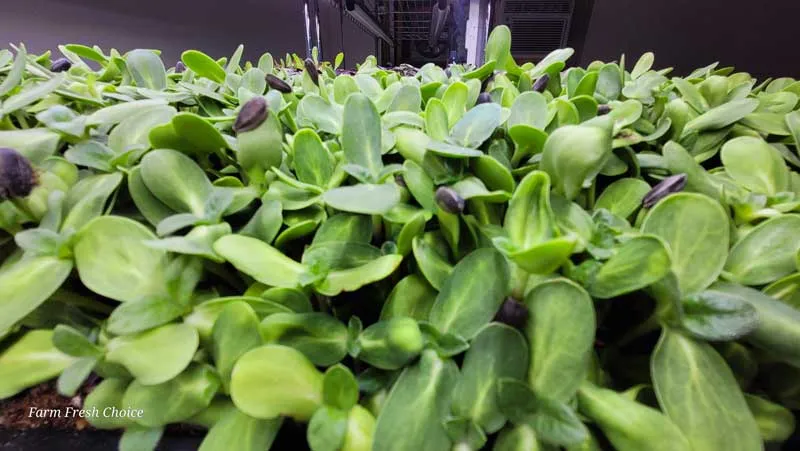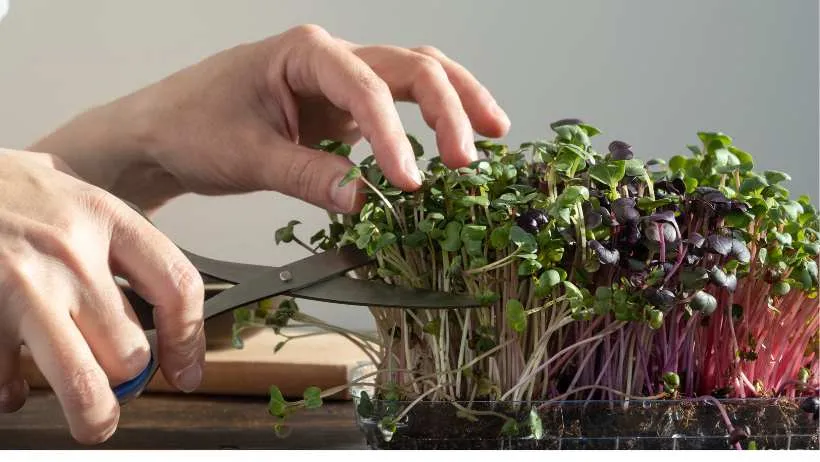Not sure exactly when to harvest your sunflower microgreens? You’re not alone—timing is one of the most common mistakes new growers make. Harvest too early, and you miss their full crunch and flavor. Wait too long, and you’ll have bitter greens and tough stems.
Sunflower microgreens grow fast, often doubling in size within 24 hours during peak growth. That means a perfect harvest window can come and go before you realize it.
If you’ve ever been unsure whether to cut them now or wait another day, this guide is for you. You’ll learn the four clear signs that your sunflower microgreens are ready—no guessing, no wasted trays, just consistent results you can taste in every bite.
Sign 1: Cotyledons Are Fully Open and Bright Green
The best time to harvest sunflower microgreens is when the cotyledons have fully opened and turned a vibrant, uniform green. These first leaves are broad and slightly oval with a smooth texture. They should look fresh and perky, not wrinkled or droopy. When you run your fingers across them, they feel firm but tender, with a slight bounce that tells you they’re hydrated and full of life.
Harvesting too early—when the cotyledons are still unfolding or pale—means the microgreens haven’t reached their ideal texture. While they can still taste good, they might feel too delicate or underdeveloped. Waiting a little longer allows the leaves to plump up and deliver that classic sunflower crunch.
Fully opened cotyledons offer a rich, nutty flavor with a subtle sweetness and satisfying bite. That balance of texture and taste makes them stand out on salads, sandwiches, and more.
Sign 2: Seed Hulls Have Fallen Off Naturally (or Are Easy to Remove)
As sunflower microgreens grow, most black seed hulls loosen and fall off naturally. This usually happens around day 7 to 10 once the cotyledons are fully open and the stems have gained strength. You’ll often see hulls scattered on the grow tray or clinging lightly to the tops of the leaves. When the timing is right, they slide off with barely a touch—no tugging needed.
If a few stubborn hulls remain stuck, don’t worry. You can gently brush them off with your fingertips or softly run your hand across the canopy of greens. Another easy trick is to place a damp paper towel over the tray for a few hours—the extra moisture helps soften the hulls, making removal even easier. Avoid pulling too hard, as it can tear the leaves or damage the stems.
Sign 3: Stems Are Thick and Sturdy, Around 3–4 Inches Tall
Sunflower microgreens develop a strong, upright stem as they mature, and this stem is where much of their crunch and structure come from. A good harvest point is when the stems reach about 3 to 4 inches tall. At this stage, they’re thick enough to stand tall without bending and feel firm when gently pressed between your fingers. The color is usually pale green to light purple near the base, with no signs of thinning or stretching.
While it might seem like taller greens are better, letting them grow too long can be detrimental. Overgrown stems tend to get stringy and hollow, losing the dense, snappy texture that makes sunflower microgreens satisfying.
Instead of watching only height, pay attention to how solid and balanced the stem looks. If they’re flopping over or starting to yellow at the base, you’ve likely waited too long. Harvesting at the 3–4 inch mark keeps everything fresh, crunchy, and flavorful.
Sign 4: True Leaves Are Just Starting to Emerge
Before sunflower microgreens form their true leaves, tiny new growth emerges between the two cotyledons. These true leaves are usually smaller, narrower, and have a different shape from the rounded cotyledons. This early stage is your cue to harvest. Waiting until this point means the microgreens have reached full flavor and texture without becoming too mature.
If you let them grow too far past this point, those true leaves expand quickly and shift the taste. What was once mild and nutty can turn bitter and fibrous. The texture also changes—leaves may toughen and lose that satisfying crunch. Timing your harvest just as the true leaves peek out helps you capture the greens at their peak.
They’ll taste fresh and clean, with the signature sunflower nuttiness and a perfect balance between tender leaves and strong stems. Checking daily around this stage is smart since growth can speed up fast once the true leaves begin to form.
Conclusion
To get the best flavor and texture from your sunflower microgreens, use all four signs together before you harvest. Fully opened cotyledons, easy-to-remove hulls, sturdy stems, and the first sign of true leaves are reliable clues. When all of these lineup, your microgreens are at their peak—crunchy, flavorful, and ready to eat. Pay attention to these cues, and you’ll get the kind of fresh, crisp microgreens that taste just as good as they look.
More Microgreen Tips & Insights
How to Prevent Mold On Sunflower Microgreens
Sunflower Sprouts: What They Look Like
How to Grow Sunflower Sprouts Microgreens
What Are Sunflower microgreens?
Sunflower Microgreens: Its Benefits and Uses







